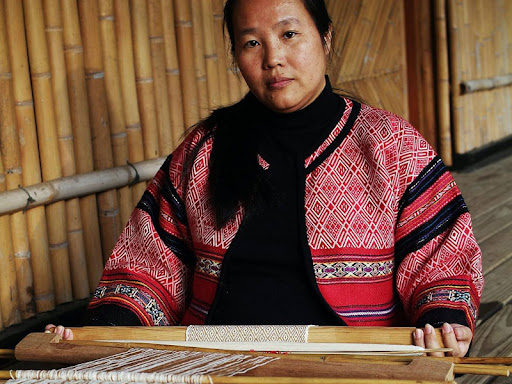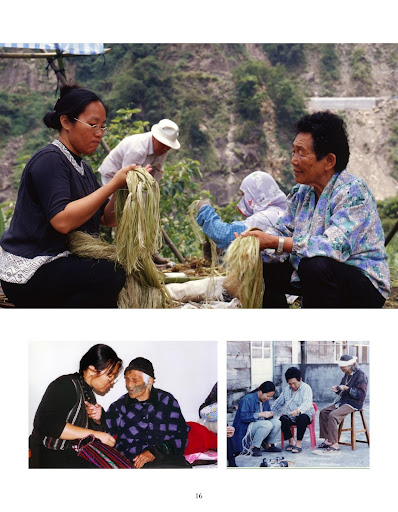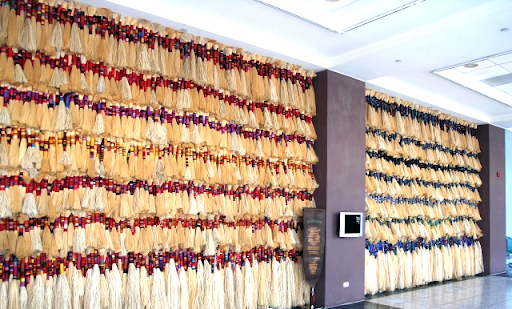< YUMA TARU >
Yuma Taru is the preserver of the Atayal weaving tradition. Her Chinese name is Huang Yali, while Yuma Taru is her indigenous name. Yuma's community, Temubawnay, only has one elementary school, so she had to live on her own after graduating from elementary school, which made her feel uneasy because she was away from home, away from tradition, and away from her original living formation, "it's as far as a living distance," Yuma says.
Yuma and the other children were told when they were young that if they wanted to have a better life, they should learn. The best jobs an indigenous woman can get are either as a government official, teacher, nurse, or law enforcement officer. These are the top jobs the Atayals want to do, and they work hard to get them. No one taught Yuma to look for what she enjoyed in school, or that the goal of education is to find and do what she likes. After graduating from Fu Jen Catholic University, she wanted to become a government employee, but a voice in her heart said, "Do I like all of this?" She first considered what she desired, and why she needed to learn. What does she require to have a better background? Why does she need a better job to acquire one? To live a joyful existence.
"But having a happy life is doing what I love and want to do!" she reasons, so she quit her job at 29. “I don’t like my job”, she thought. Although Yuma did a great job on her work and gets awarded accomplishments, she wants her life to be colorful and full of what she enjoys and likes. She knew before 65 years old her life would just be unremarkable
, and that’s not what she wanted. No one knows Yuma quit her job for quite some time, when her mother finds out, she was so angry that she told all her relatives not to help her, give her food to eat, or even not to give Yuma a place to live. Her mother wants Yuma to understand the cruelness of society and get back to the job of a civil servant, “Why come back if you have a great background and great job?”, was her mother’s idea.
Yuma gave up her educational background and came up back to the mountains again, she was able to change her life, but she came back, it was a family revolution until her grandmother took her in, so in the daytimes she and her grandmother picked fruits, and in the nighttimes, her grandmother taught her how to weave.
After some weeks back in the home, Yuma met five young men from different village communities, back then, the government didn’t encourage indigenous youngs to return home, it wasn’t optimistic for them to go back into the mountains. Yuma and the five young men saw the Atayal’s culture slowly disappearing and withered, they determined to bring their culture back, they organized their culture and tradition, how the past Atayals do things, how they live, how the Atayals used to do everything. In the five young men, one was a priest, one was evangelist, another was a teacher, an airman… one researched for traditional festivals, language, history, migration… and Yuma was the only woman, so the men gave her one job, to do weaving research. At first, Yuma didn’t want to study weaving, because weaving is the lowest status in the social class of Atayal, but she had to do it, according to Gaga (Atayal’s ancestry rules), only women are allowed to weave, they don’t want to violate Gaga since they are recovering the tradition, so Yuma started to put a lot of effort in learning how to weave, from her grandmother, and she unconsciously started to like weaving.
Yuma explained, “Weaving out good work requires good mathematics and technique, so there’s only a few that can master the art of weaving”. She has hundreds of students learning how to weave out different patterns. The different clothes were originally spread across all countries, Germany, France, Spain, Portugal, Netherlands, Japan, Canada, America, and China, the hand-knitted clothes were everywhere, Yuma excavated the works from all over the world and made Atayal's culture reappear. After the 1940s, Atayal’s culture slowly disappears, and Yuma is digging the Atayal spirit out, out of her deep heart.


Image: Provided by Yuma Taru (2021)
wHAT SHE DID
-The first decade
Yuma Taru has done a lot during the past 30 years. In 1990, she started to work and learn about the Atayal weaving technique and patterns. During the time until 1999, she first did fieldwork and then, she went to museums for research analysis, including pattern analysis. Meanwhile, she learned about the traditional weaving and thread-making process.
-The second decade
In the next 10 years, from 1999 to 2009, she began to revive the traditional technique of Atayal weaving at the Da’an River Basin. She cultivated weavers in her tribe, also started remaking inheriting the traditional Atayal customs.
- The third decade
From 2010, she experimented with tradition in modern days, which combined the weaving tradition with modern fashion, and made an innovation of the Atayal weaving tradition.
1.traditional innovation
2. Fiber Art Creation
2.1 The gyration of life
2.2 river war
2.3 Island Seasons
2.4 Spread the wings of your dreams
-The fourth 10 years
Finally, from 2020, until now, Yuma Taru has studied the application of ramie, and its circular economy. The application of circulatory systems in the ramie plant includes eco-friendly farming, and the planting of non-toxic fruits and vegetables. Also, she started to inherit the traditional weaving skills to others. Therefore, while she is an artistic creator and revivalist, she is also a teacher who is inheriting Atayal weaving skills.

Image: Provided by Yuma Taru (2021)
Work


Image: Provided by Yuma Taru (2021)
Image: Provided by Yuma Taru (2021)